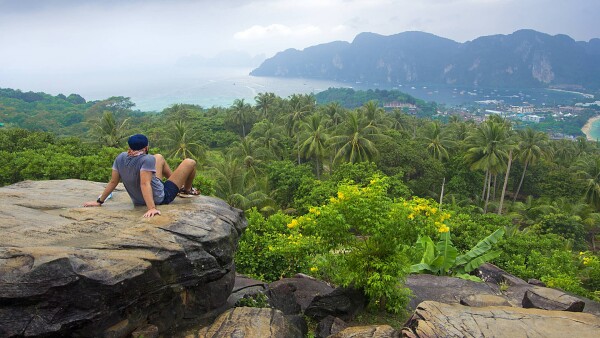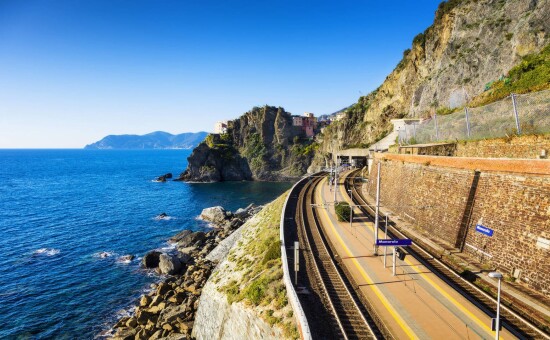Backpacking Thailand: The banana pancake trail and other backpacker hotspots
Ever heard of the Banana Pancake Trail? Learn about this infamous Thailand backpacking route and other hotspots in the region.

This post may contain affiliate links. If you use these links, we may earn a small commission. Thanks for your support.
Ever since Joe Cummings made Bangkok’s Khao San Road famous in the very first Lonely Planet Thailand guide in the early 1980s, it has been a mecca for backpacking in Thailand.
Meanwhile, the Banana Pancake Trail has appeared. Its name derives from the super cheap and sticky-sweet banana pancakes that street vendors typically offer through Thailand, Cambodia, Indonesia, Laos, Malaysia, Myanmar, Philippines, and Vietnam. The far reaches even extend to China, India, and Nepal.
Wanderers from all over the world have been trading travel tips on the best Thai islands and best Thailand beaches for decades. Along the banks of the Mekong River, across many dorms and shady backyard bars, the backpacker scene has lived to tell the tale.

Well-known for its mouth-watering cuisine, mind-boggling scenery, riveting culture and budget-friendly cost of living, Thailand is considered a must-see destination by South East Asia’s banana-pancake travelers. While the places-to-visit list keeps evolving, here’s a rundown of where to go in Thailand on a shoestring.
Hit Bangkok’s Khao San Road

Two old Chinese-style hotels (and Joe Cummings) paved the way for the world’s largest backpacker center by the mid-1990s. While we have yet to find someone who offers us snake blood, like in the 2001 movie The Beach starring Leonardo DiCaprio, five-dollar rooms, low-priced jeans, and the cheapest Pad Thai in town are readily available on Khao San Road. It’s the street that never sleeps and the hub of the Banana Pancake Trail.
And let’s not forget the fake certificates and Thailand secrets that are the stuff of legend on this Thailand backpacking route.
The friendly vibe is also palpable in Chinatown, at floating markets, and the numerous parks of Bangkok—an exciting metropolis with plenty of things to see and do.
Besides, you won’t have to blow your Thailand backpacking budget to visit Bangkok, or the City of Angels, as it’s called in Thai. You can get here by jumping on buses and third-class trains.
Experience the epitome of backpacker vibes in Pai
Pai epitomizes that Thailand backpacking vibe the kingdom is known for. With only 3,000 people, it offers a small-town countryside ambiance. While that’s already enough for some backpackers, Pai is blessed with natural springs, gushing waterfalls, and white-water rapids. Engulfed by gorgeous hills, dense bamboo, and teak forests, Pai is home to the Chinese Yunnan hill tribe people that escaped Communist China in the mid-20th century.
Pai boasts many wallet-friendly places to stay, eateries and bars, and a backpacker community like nowhere else in Thailand. And it’s easy to get between Pai and Chiang Mai, my next destination on Thailand’s backpacking route.
Visit the Rose of the North—Chiang Mai
Embedded in a green valley, Thailand’s “Rose of the North” got its name from the once underdeveloped urban scenery and clean air. While the rose has withered over the years, 725-year-old Chiang Mai has managed to preserve its cultural and artistic heritage, despite the tourist boom that’s been happening here.
Situated on the banks of the Ping River, affordable boutique hotels, modern condos, and entertainment venues are side by side with golden dragons and mosaic-encrusted temples.
Chiang Mai is a backpacker draw, and rightly so, as the rumored tranquility still exists. What the heart of the north lacks in famous Thailand beaches and parties, it more than makes up for with small villages, mountains like Doi Inthanon, local color, and authentic Khao Soi, a coconut curry noodle soup.
Whether you visit Chiang Mai’s sleepy sister town, Chiang Rai, first or make a beeline for Chiang Mai doesn’t matter. Important is that you travel along the Lanna trail. This name nods to the former Lanna Kingdom of present-day Northern Thailand. The bus trip from Chiang Mai to Chiang Rai (and vice versa) takes three hours.
You can also take a minivan from Chiang Mai to Pai, which will take approximately three and a half hours.
Make your own history in Kanchanaburi

Kanchanaburi’s appeal is not just its 300m-long death railway bridge to Myanmar, constructed by Japan’s World War II prisoners. It also has a casual mood and enchanting surroundings popular with backpackers. Kanchanaburi has plenty of hostels and offers exuberant nightlife. In addition, it’s only a convenient 2.5-hour minivan ride from Bangkok.
If you ride the historic train, you’ll be rewarded with unforgettable river views. And checking out the Hellfire Pass is a terrifying and poignant experience. Erawan Falls, one of Thailand’s staggering waterfalls, is also located in the area.
Minibuses to Kanchanaburi frequently run from Bangkok.
You can also get to Kanchanaburi from Ayutthaya, a city that boasts ancient temple ruins.
Koh Phangan, Koh Samui, Koh Tao: Choose your paradise

As you approach the country’s southernmost area, you enter the lovely beach segment of the Thailand backpacker route. You’re really spoiled for choice when it comes to beaches here.
Koh Phangan and its full moon parties are famous the world over, but there is a lot more to do than party.
For the ultimate backpacker vibe, head to Zen Beach an hour or so before sunset, and you’re bound to meet like-minded travelers. They meet there every day to play the drums, chat, and chill with lovely people.
Neighboring Koh Samui is an excellent starting point for exploring the Gulf of Thailand, with a wide range of affordable accommodations, palm-fringed beaches, and vibrant nightlife in Chaweng and Lamai.
And Koh Tao is a terrific site for scuba diving and snorkeling.
Since you’re a backpacker, we recommend the night train ride from Bangkok to Suratthani. And then, you can hop on a minivan to Don Sak, where the ferry waits to take you to any of the islands mentioned above.
Complete your Thailand backpacking journey in Koh Phi Phi

Koh Phi Phi is more than the fabled Maya Bay, where The Beach was filmed. Its fine white-sand beaches, green-tinted waters, and views of giant limestone rocks rival Phuket, Thailand’s beaches.
Tonsai Village is the place to be on Koh Phi Phi Don; backpackers almost entirely populate it. Therefore, it’s no surprise that you’ll find a globetrotting selection of inexpensive hotels, hostels, restaurants, massage parlors, and bars at Tonsai. Also, there are plenty of dive shops, and Koh Phi Phi’s nightlife (and “day life!”) is one-of-a-kind.
Depending on the Covid situation, there are daily ferries from Ao Nang to Koh Phi Phi, Phuket to Koh Phi Phi, and Koh Lanta to Koh Phi Phi.
When to go to Thailand
As for when to go to Thailand, that’s entirely up to you. While the country sees tourism all year, the masses thin out in the rainy season, typically from September to mid-December. So, when rainfall is more common (there are still periods of sunshine), you’ll get cheaper hotel prices, and there will be fewer crowds.

Either way, you’re going to meet people traveling on the cheap and following the Banana Pancake Trail. If you have more time to travel, check out our full 2-3 week Thailand itineraries. Backpacking in Thailand has been influenced by decades of hippies traveling on the ground and making the way for you.
So, what are you waiting for?
FAQ
There isn’t a bad time to go. It all depends on what you are looking for. And even in the rainy season it rarely rains all day. Tropical rains are fast and furious and once they are over the sky clears up and its blue skies all around.
2-4 days will give you a great overview of the city.
It is possible to spend as little as $5 a day, but only if you eat street food, and a lot of banana pancakes. And that doesn’t include drinks.






